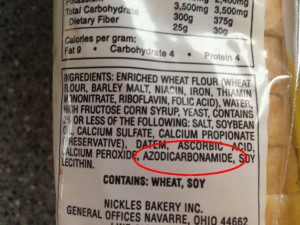Guest Writer for Wake Up World
The recent revelation that Subway bread contains azodicarbonamide has gotten a lot of attention. And it should… azodicarbonamide is a dangerous industrial chemical used to make yoga mats, shoe rubber, and synthetic leather. Although there’s no reason for it to be in bread, it has in fact been used for decades as a dough conditioner. The public backlash was so great that Subway has stated it will cease to use azodicarbonamide as a food additive… although Subway stopped short of providing concrete deadlines as to when, so be aware.
So… what is azodicarbonamide? And what are the health risks associated with exposure and consumption? Because it’s used to make foamy yoga mats, please understand that it isn’t safe to consume, and the next 9 facts will explain why.
1. Azodicarbonamide is an Industrial Chemical
The primary function of azodicarbonamide is centered on the way it breaks down during processing — it creates tiny bubbles that make things “foamy.” Somewhere in the testing procedures, scientists discovered it whitened flour and acted as an oxidizing agent. Bakers, or rather “food scientists” soon concluded that it should be a standard inclusion in bread.
2. Azodicarbonamide Increases Gluten Content in Bread
Oxidizing agents like azodicarbonamide are used to increase gluten content. This is “desirable” because higher levels of gluten create stronger, more durable dough. The added convenience to processing isn’t without other risks though. Gluten has been linked to a host of gastro-intestinal, immunologic and neurologic diseases. [1] [2]
3. Azodicarbonamide Can Cause Respiratory Problems
Research has established a direct link between exposure to azodicarbonamide and the onset of asthma. [3] According to a World Health Organization (WHO) follow-up report, regular occupational exposure to azodicarbonamide can lead to asthma and allergies. The WHO report notes many of those who developed asthma and other respiratory complications experienced symptoms within just three months of exposure. [4]
4. Azodicarbonamide is a Skin Irritant
The WHO report also noted physical exposure to azodicarbonamide caused recurring dermatitis. [4] Fortunately for those suffering, eliminating exposure caused the indications of the dermatitis to go away. While this is good news, these results show how quickly industrial chemicals can initiate an autoimmune response. Unfortunately, skin irritation seems to be the least of concerns…
5. Azodicarbonamide Disrupts the Immune System
In 2001, lab tests found that direct exposure to azodicarbonamide inhibited human immune cell formation and function. [5] Although “direct exposure” may be less of a common problem, the bigger problem happens when azodicarbonamide is heated up, as when it’s a bread ingredient…
6. Azodicarbonamide Creates Toxic By-Products When Heated
While azodicarbonamide is used to condition bread dough, when it’s baked, the heat causes it to break down. Two by-products can result: semicarbazide and ethyl carbamate. Semicarbazide belongs to a family of chemicals known as hydrazines that are especially carcinogenic. A 2003 study using animal models found that it caused free radical damage to DNA. [6] Other studies have found that semicarbazide damages human immune cells and the DNA of animals. [7]
The other half of the gruesome twosome is no better. The National Institute of Health’s Hazardous Substances Data Bank states that ethyl carbamate is a carcinogen to animals; in fact this is backed by over 200 studies. [8] [11] Research from 17 years ago confirmed that adding azodicarbonamide to bread increased ethyl carbamate levels. [12] The awful truth is that industry has known for nearly two decades that this is toxic trash and fed it to us anyway.
7. Harmful to Hormone Function
Exposure to semicarbazide can present another health risk. Animal studies have found it has a toxic impact on hormone function and the hormone-regulating organs, including the thyroid, thymus, spleen, testes, ovaries, and uterus. [9] [10] As is the case with all endocrine disrupting compounds, this stuff is poison!
8. Europe and Australia Have Banned It
While US Officials continue to claim the amount of azodicarbonamide found in most baked products poses no serious health threat, European and Australian officials have banned its use in bread. Baby food jars were another source of exposure and officials were left without answers concerning the “safe levels” for infants. [13] Consequently, European officials disallowed its use in sealing glass jars.
9. Subway is Not the Only Violator
An NBC news piece released shortly after Subway’s bread revelation identified several other restaurants whose food contained azodicarbonamide. These include McDonald’s, Burger King, Wendy’s, Arby’s, Jack in the Box, and Chick-fil-A. [14] Although not all bread from these restaurants may contain azodicarbonamide, is it worth the risk? Bottom line — if you want to avoid it, get in contact with the corporate big wigs who control restaurants from afar and verify they’ve made a pledge not to use any azodicarbonamide.
A Final Thought….
“Health officials” may claim this trash is safe in low doses, but who’s monitoring exposure? And let’s face, at any level a toxin is a toxin. If it doesn’t contribute to health, it’s taking away from it. As I’ve said for years, disease happens when toxic buildup in the body becomes too great. The best approach for encouraging good health continues to be eating a diet of natural, organic foods from trusted sources and regularly detoxifying your body.
– Dr. Edward F. Group III, DC, ND, DACBN, DCBCN, DABFM
References:
- Pietzak M. Celiac disease, wheat allergy, and gluten sensitivity: when gluten free is not a fad. JPEN J Parenter Enteral Nutr. 2012 Jan;36(1 Suppl):68S-75S. doi: 10.1177/0148607111426276.
- Hernandez-Lahoz C, Mauri-Capdevila G, Vega-Villar J, Rodrigo L. [Neurological disorders associated with gluten sensitivity]. [Article in Spanish] Rev Neurol. 2011 Sep 1;53(5):287-300.
- Kim CW, Cho JH, Leem JH, Ryu JS, Lee HL, Hong YC. Occupational asthma due to azodicarbonamide. Yonsei Med J. 2004 Apr 30;45(2):325-9.
- Mr R. Cary, Dr S. Dobson, Mrs E. Ball. Azodicarbonamide. Concise International Chemical Assessment Document 16. World Health Organization, 1999. (last accessed 2014-02-17)
- Tassignon J, Vandevelde M, Goldman M. Azodicarbonamide as a new T cell immunosuppressant: synergy with cyclosporin A. Clin Immunol. 2001 Jul;100(1):24-30.
- Hirakawa K, Midorikawa K, Oikawa S, Kawanishi S. Carcinogenic semicarbazide induces sequence-specific DNA damage through the generation of reactive oxygen species and the derived organic radicals. Mutat Res. 2003 Apr 20;536(1-2):91-101.
- Vlastos D, Moshou H, Epeoglou K. Evaluation of genotoxic effects of semicarbazide on cultured human lymphocytes and rat bone marrow. Food Chem Toxicol. 2010 Jan;48(1):209-14. doi: 10.1016/j.fct.2009.10.002. Epub 2009 Oct 9.
- NLM. METHYL CARBAMATE. (last accessed 2014-02-17)
- Maranghi F, Tassinari R, Lagatta V, Moracci G, MacrଠC, Eusepi A, Di Virgilio A, Scattoni ML, Calamandrei G. Effects of the food contaminant semicarbazide following oral administration in juvenile Sprague-Dawley rats. Food Chem Toxicol. 2009 Feb;47(2):472-9. doi: 10.1016/j.fct.2008.12.003. Epub 2008 Dec 10.
- Maranghi F, Tassinari R, Marcoccia D, Altieri I, Catone T, De Angelis G, Testai E, Mastrangelo S, Evandri MG, Bolle P, Lorenzetti S. The food contaminant semicarbazide acts as an endocrine disrupter: Evidence from an integrated in vivo/in vitro approach. Chem Biol Interact. 2010 Jan 5;183(1):40-8. doi: 10.1016/j.cbi.2009.09.016.
- EPA. Ethyl Carbamate (Urethane). Hazard Summary-Created in April 1992; Revised in January 2000. (last accessed 2014-02-17)
- Dennis MJ, Massey RC, Ginn R, Parker I, Crews C, Zimmerli B, Zoller O, Rhyn P, Osborne B. The effect of azodicarbonamide concentrations on ethyl carbamate concentrations in bread and toast. Food Addit Contam. 1997 Jan;14(1):95-100.
- European Food Safety Authority. EFSA publishes further evaluation on semicarbazide in food. July 1, 2005. (last accessed 2014-02-17)
- Little, Katie. That Chemical Subway Ditched? McDonald’s, Wendy’s Use it Too. (last accessed 2014-02-17)
Previous articles by Dr. Group:
- 13 Natural Remedies For Radiation Exposure
- 8 Must-Know Facts About Fukushima Nuclear Radiation
- Nine Shocking Dangers of Fluoride Exposure
- 10 Natural Remedies for Kidney Stones
- The 9 Best Herbs for Lung Cleansing and Respiratory Support
- 12 Uses For Iodine … and Other Tips, Research, and Resources
- The Benefits of Himalayan Salt
- Lung Cleansing With Peppermint Oil
- How to Flush the Liver
- Natural Remedies For Bad Breath
- 10 Foods That Detox the Body
- The Benefits of Organic Hemp Milk + How to Make Your Own
- Seven Facts You May Not Know About Coconut Oil
About the author:
 Dr. Edward F. Group founded Global Healing Center in 1998 and is currently the Chief Executive Officer. Heading up the research and development team, Dr. Group assumes a hands-on approach in producing new and advanced degenerative disease products and information.
Dr. Edward F. Group founded Global Healing Center in 1998 and is currently the Chief Executive Officer. Heading up the research and development team, Dr. Group assumes a hands-on approach in producing new and advanced degenerative disease products and information.
Dr. Group has studied natural healing methods for over 20 years and now teaches individuals and practitioners all around the world. He no longer sees patients but solely concentrates on spreading the word of health and wellness to the global community. Under his leadership, Global Healing Center, Inc. has earned recognition as one of the largest alternative, natural and organic health resources on the Internet.

If you've ever found value in our articles, we'd greatly appreciate your support by purchasing Mindful Meditation Techniques for Kids - A Practical Guide for Adults to Empower Kids with the Gift of Inner Peace and Resilience for Life.
In the spirit of mindfulness, we encourage you to choose the paperback version. Delve into its pages away from screen glare and notifications, allowing yourself to fully immerse in the transformative practices within. The physical book enriches the learning process and serves as a tangible commitment to mindfulness, easily shared among family and friends.
Over the past few years, Wake Up World has faced significant online censorship, impacting our financial ability to stay online. Instead of soliciting donations, we're exploring win-win solutions with our readers to remain financially viable. Moving into book publishing, we hope to secure ongoing funds to continue our mission. With over 8,500 articles published in the past 13 years, we are committed to keeping our content free and accessible to everyone, without resorting to a paywall.







